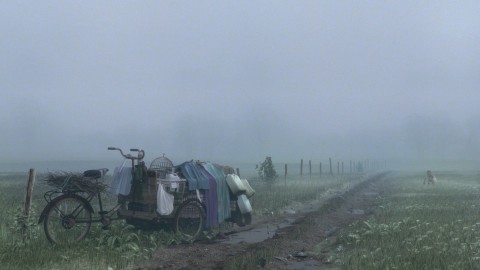Wonder, quietude, and introspection conveyed through uncanny objects and tragicomic scenarios characterize much of the multidisciplinary practice of Hans Op de Beeck. At the same time, his large installations, sculptures, films, videos, photographs, paintings, drawings, texts, theater, and music ironically and melancholically reflect universal questions about the meaning of life and death.
Op de Beeck, born in Turnhout in 1969, lives and works in Brussels and Gooik, Belgium. He received his master’s degree in visual arts from Higher Institute Sint-Lukas, Brussels, in 1996. Early in his career, he began to capture or create moments of tranquility and peculiarity. Coffee (1999) is a two-and-a-half-minute candid video of an elderly couple drinking coffee in a café in palpable, painful silence. The woman stares fixedly into space, intermittently glancing at her companion, as the man sits with his back to the camera, his motionless presence successfully conveying stoicism. The following year, Op de Beeck created Exercising Nowheres (2000), a series of models representing abandoned urban spaces—a completely taupe view of a ticket counter in an abandoned train station and a blue unicolor model of an empty swimming pool stadium. Their emptiness, monochromatic colors, and reduced scales allow the viewer to calmly contemplate details that often go overlooked. As in Coffee, Exercising Nowheres employs uniformity and stillness to absorbing effect.
Suggestions of and reflections on mortality recur in Op de Beeck’s work. Determination (New York Kids) (2003) is a series of muted photographic portraits of children with their eyes closed. Op de Beeck asked the kids to imagine that they were a different person or in another place, and, in many cases, one can read the concentration and “determination” to do so on their faces. With disembodied heads set against opaque black backgrounds, Op de Beeck’s stark design suggests the strength of mind and character, rather than the assumed immaturity, of young children. At the same time, the format hauntingly recalls death masks.
Op de Beeck also has created numerous tablescapes, vanitas sculptures, and monumental sculptures of day-old cakes in unexpected mediums that serve as memento moris and recall Dutch still life paintings as well as Daniel Spoerri’s “snare-pictures” (assemblages displaying the remains of meals on tables or boards). Frozen Vanitas (2015) is a round table displaying a collection of modern and classic objects, such as fruit, candles, a skull, and open books. Made entirely of colorless, sandblasted glass, it disquietingly resembles an ice sculpture that never melts. Both After the Gathering (2007) and Memento Mori (2017) present enlarged representations of sliced, half-eaten cakes. The fallen fruit and candles and melted cream and icing that embellish the sculptures symbolize the passing of time and the proximity to death that birthday celebrations ironically mark. A series of sculptures, Vanitas Table (2016), also alludes to seventeenth-century vanitas paintings. The works combine both traditional and contemporary items, including plants, bottles, instruments, vases, fruit, skulls, cigarettes, and mobile phones, and are sculpted from monochrome gray plaster.
From 2014 to 2016, Op de Beeck also used gray plaster to produce Characters, a series monochromatic, life-sized sculptures depicting children and adults engaging in mundane activities—reading, playing, sleeping, or listening to music. Reminiscent of the bodily remains of Pompeii, the figures evoke death with their ashen color, but the pieces also serve as monuments to everyday life. Instead of military battles or heroic acts, they memorialize the activities in which all of us can or have taken part.
Op de Beeck’s gray figures and objects converge in the monumental installation The Collector’s House (2016). This immersive space is an example of what Op de Beeck describes as “‘visual fictions’: tactile deserted spaces as an empty set for the viewer to walk through or sit down in, sculpted havens for introspection.” The interior—a reception room with a grand piano, a library, vanitas tables, a collection of paintings, stuffed animals, and life-sized figures as well as a lily pond in the center—is entirely gray, creating an image of people and objects turned into stone. The Collector’s House exemplifies the way in which Op de Beeck’s surreal figures, imagery, and installations inspire moments of silent introspection on the part of the viewer, who is invited to enter and contemplate the eerie surroundings.
The Garden of Whispers (2016) also is an interactive, immersive space. Conceived for the enormous refectory of Les Jacobins in Toulouse, France, the installation comprises large hills of sands, through which Op de Beeck cut a winding path covered with wooden slats and illuminated by a string of lights. Leafless trees appear sporadically along the hills as do small encampment areas with tents, mats, containers, and campfires. Accompanied by a soundscape of whispering voices that permeates the garden, several actors calmly perform small, everyday acts and at times silently offer tea to visitors.
The Girl, a recorded performance, presents a silent actor in staged, fictive scenarios that evoke the serenely disquieting qualities of Op de Beeck’s art since the early 2000s. For its duration, the video cuts to and pauses on various hazy, rainy, and/or nocturnal views of an abandoned house, field of flowers, elevated highway, gas station, and playground, among other sites. Most of these settings are unpopulated or capture long shots of “The Girl” within the scene. Intermittently, Op de Beeck also inserts close-ups of her resting face. Eventually he reveals the child, enveloped in a fog and lying on a raft floating in a body of water. Her eyes are closed, shielding the viewer from her emotions or thoughts, yet cuts on her cheeks and the display of her belongings packed onto the raft suggest a tragic narrative. As she reclines, possibly imagining or perhaps escaping the world represented by the aforementioned locations, a haunting song composed by Tom Pintens and based on a text by the artist accompanies the montage. Thus, as it subtly evokes danger and mystery, The Girl also typifies Op de Beeck’s art and provides moments of contemplative beauty. —Kanitra Fletcher

